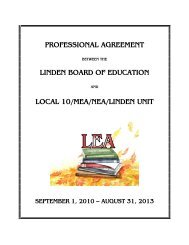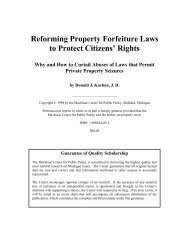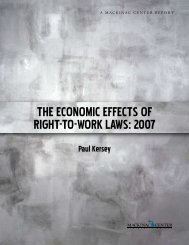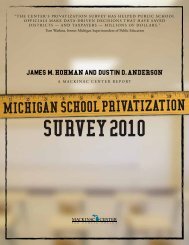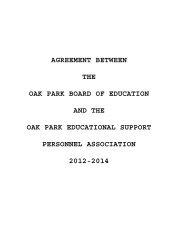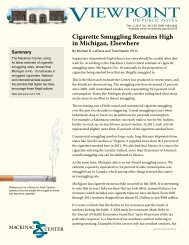The Case for Choice in Schooling - Mackinac Center
The Case for Choice in Schooling - Mackinac Center
The Case for Choice in Schooling - Mackinac Center
- No tags were found...
Create successful ePaper yourself
Turn your PDF publications into a flip-book with our unique Google optimized e-Paper software.
<strong>The</strong> <strong>Case</strong> <strong>for</strong> <strong>Choice</strong> <strong>in</strong> School<strong>in</strong>g:Restor<strong>in</strong>g Parental Control of EducationMack<strong>in</strong>ac <strong>Center</strong> <strong>for</strong> Public Policyof government control and skyrocket<strong>in</strong>g <strong>in</strong>creases <strong>in</strong> education spend<strong>in</strong>g. <strong>The</strong> evidence of acrisis <strong>in</strong> public education is everywhere.CONSOLIDATION OF SCHOOL DISTRICTSIn 1940, the United States had over 117,000 school districts with an average of 217students per district. By 1997, the government school system had consolidated schools <strong>in</strong>tofewer than 15,000 regular school districts with an average of more than 3,000 studentsenrolled <strong>in</strong> each district. 39<strong>The</strong> dramatic reduction of school districts and the <strong>in</strong>crease <strong>in</strong> student populationdilutes the parental <strong>in</strong>fluence on their children’s education. Whereas smaller districtsallowed <strong>for</strong> greater parental <strong>in</strong>volvement because school board members and school officialswere more accessible and had fewer constituents, larger districts have dim<strong>in</strong>ished the role ofparents and <strong>in</strong>creased the <strong>in</strong>fluence of special <strong>in</strong>terest groups. This effect is unavoidablewhen districts consolidate and become more bureaucratic.BALLOONING COSTSGovernment school officials consistently assert that it is a lack of fund<strong>in</strong>g that hasprevented schools from be<strong>in</strong>g effective. Between 1970 and 1997, however, total revenues<strong>for</strong> public schools <strong>in</strong>creased from $44.5 billion to $305 billion, yet scores on the SAT havedropped by 27 po<strong>in</strong>ts at the same time. 40<strong>The</strong> United Statesannually spends$740 billion oneducation, ornearly 10 percentof the nation’sgross domesticproduct—morethan it spends ondefense and SocialSecurity comb<strong>in</strong>ed.Government school<strong>in</strong>g <strong>in</strong> the United States has become <strong>in</strong>creas<strong>in</strong>gly expensive totaxpayers. In the 1969-70 school year, every man, woman, and child <strong>in</strong> the United Statescontributed $850 (<strong>in</strong> 1996-97 dollars) to support government schools. By the 1996-97 schoolyear, expenditures grew to $1,181 per citizen, or more than $313 billion per year. 41 Some putthe expenditures on education at a much higher level. Accord<strong>in</strong>g to research by MerillLynch, a global <strong>in</strong>vestment firm, the United States annually spends $740 billion oneducation, or nearly 10 percent of the nation’s gross domestic product. That amount is morethan the nation spends on defense and Social Security comb<strong>in</strong>ed. 42PLUMMETING STUDENT ACHIEVEMENT<strong>The</strong> Third International Mathematics and Science Study (TIMSS) was adm<strong>in</strong>isteredto a half-million students from 41 countries <strong>in</strong> 1995. <strong>The</strong> results showed that the UnitedStates is the only country <strong>in</strong> which children do worse the longer they stay <strong>in</strong> school. Of the21 countries participat<strong>in</strong>g <strong>in</strong> the 12th-grade general knowledge tests of math and science, theUnited States ranked 19th and 16th, respectively. 43 Critics of <strong>in</strong>ternational tests like TIMSScontend that American students suffer by comparison because other countries educatesmaller proportions of their populations and test only “elite” students. But researchers haveshown that <strong>in</strong> all 21 countries, 90 percent or more of teenagers were enrolled <strong>in</strong> school,which suggests the test is a valid comparison between American students and their <strong>for</strong>eigncounterparts. 44February 2001 13



